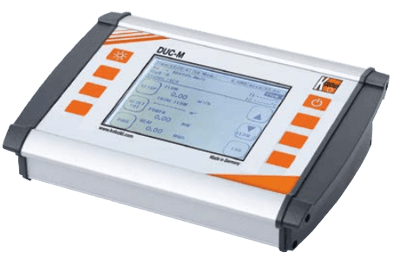DUC-M Ultrasonic Transmitter Flowmeter
Brand: KOBOLD Instruments, IncDUC uses the effect of acceleration and deceleration of acoustic signals travelling in a moving fluid. Two ultrasonic clamp on transducers are mounted (from outside) on a pipe and produce an acoustic path.
The transducers send and receive acoustic signals and the transit times t1 and t2 are measured by an electronic flow transmitter.
The signal from transducer A towards transducer B is accelerated by the flow (short t1). The return signal from transducer B to transducer A is decelerated by the flow (longer t2). The difference between t1 and t2 together with the path length L can be used to determine the average flow velocity.
This principle is known as the acoustic time-of-flight principle. The flow is calculated from the geometry data of the pipe and the flow velocity.
DUC emits coded signal pattern into the pipe. The received signals will be compared with the sent signals and only signal pattern which correlates with the original one will be used for flow calculation (cross correlation based signal evaluation).
The calculation of the flow is done with the integrated DSP (digital signal processor). Thus the calculation has high sampling rates. The DSP calculation of the time-of-flight is a pure digital transit time measurement, it works very precise, is completely drift and maintenance free and there is no need for recurring calibrations.
Specifications
Accuracy
- Up to 1 %
Applications
- Air Conditioning Systems
- Chemical & Petrochemical
- Cooling Water System
- Food & Beverage
- Heating Equipment
- Power Plants
- Pump Protection
- Water Treatment
Communication
- Micro USB
- RS-232
- RS-485 Modbus Communication Protocol
Connection Style
- BNC- Connection
- Screw Terminals
Damping Adjustment
- 0 to 100 seconds
Diagnostics
- Amplitude
- Energy
- Evaluation of Signal
- Oscilloscope Function for Graphical Display
- Signal Quality
- Signal Strength
- SNR
- Ultrasonic Velocity
Dimensions
- 260 x 240 x 120 mm
- 265 x 190 x 70 mm
Display
- Adjustable Backlight
- Black & White
- QVGA (320 x 240)
Enclosure, Body Material
- ABS
- Aluminum
Environmental Protection
- IP40
- IP65
Flow Rate
- -30 to 30 m/sec
Input
- Pt100
Media
- Ultrasonic Conducting Liquids
Mounting
- Wall Mounted
Operating Temperature
- -40° to 150° C (-40° to 302° F)
Output
- 1 x Pulse with 1-Channel
- 2 x Pulse with 2-Channel
- 4-20 mA
Output Format
- Relay Output
Power Requirement
- 100-240 Vac
- 90-240 Vac
- Optional 18-36 Vdc
Unit of Measure
- Metric


